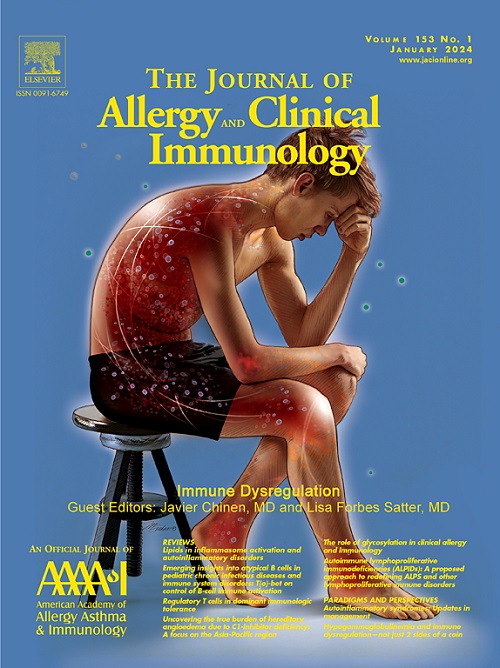Expansion of multiple CD4+ T cell lineages in lymphocytic variant hypereosinophilic syndrome.
IF 11.4
1区 医学
Q1 ALLERGY
引用次数: 0
Abstract
BACKGROUND Lymphocytic variant hypereosinophilic syndrome (LHES) is a rare disorder characterized by hypereosinophilia, the presence of phenotypically aberrant populations of Th2 lymphocytes and varied clinical manifestations. Although disease pathogenesis has historically been attributed to IL-5 driven hypereosinophilia, response to eosinophil-lowering biologics is not universal, suggesting a more direct role for the aberrant lymphocyte population in disease pathogenesis. OBJECTIVE To further delineate the surface phenotypes and cytokine profiles of the aberrant lymphocyte populations in patients with LHES METHODS: Multiparameter flow cytometry was used to analyze lymphocytes in whole blood and stored peripheral blood mononuclear cells from a cohort of 42 untreated and treated patients with LHES. RESULTS Surface receptor profiling of the aberrant population in 22 untreated patients with LHES, including 8 patients with episodic angioedema with eosinophilia (EAE), confirmed prior data demonstrating that the aberrant CD4+ T cell populations in LHES have a Th2 memory phenotype. CCR8 was identified as a dominant surface marker, unaffected by sample processing or patient treatment status. Serum levels of CCL1, the ligand for CCR8 were increased in LHES patients compared to patients with other HES subtypes. Expanded populations of Foxp3+Helios+CCR8+ regulatory T cells were identified in many patients with CD3loCD4+ LHES and correlated with the size of the CD3loCD4+ population. CONCLUSION These data provide further evidence for direct involvement of the aberrant T cell populations in disease pathogenesis in LHES and a rationale for further exploration of T cell-directed therapies.淋巴细胞变异型嗜酸性粒细胞增多综合征中多个CD4+ T细胞系的扩增。
背景:淋巴细胞变异性嗜酸性粒细胞增多综合征(LHES)是一种罕见的疾病,其特征是嗜酸性粒细胞增多、Th2淋巴细胞表型异常和多种临床表现。虽然疾病的发病机制历来归因于IL-5驱动的嗜酸性粒细胞增多,但对嗜酸性粒细胞降低的生物制剂的反应并不普遍,这表明异常淋巴细胞群在疾病发病机制中起着更直接的作用。目的进一步描述LHES患者异常淋巴细胞群的表面表型和细胞因子谱。方法:采用多参数流式细胞术分析42例未经治疗和治疗的LHES患者全血淋巴细胞和储存的外周血单个核细胞。结果对22例未经治疗的LHES患者(包括8例发作性血管性水肿伴嗜酸性粒细胞增多症(EAE)患者)的异常群体进行表面受体分析,证实了先前的数据,表明LHES中异常的CD4+ T细胞群具有Th2记忆表型。CCR8被确定为显性表面标记,不受样品处理或患者治疗状态的影响。与其他HES亚型患者相比,LHES患者血清CCL1 (CCR8的配体)水平升高。在许多CD3loCD4+ LHES患者中发现了Foxp3+Helios+CCR8+调节性T细胞的扩增群体,并与CD3loCD4+群体的大小相关。结论这些数据进一步证明了异常T细胞群直接参与LHES的发病机制,并为进一步探索T细胞定向治疗提供了理论依据。
本文章由计算机程序翻译,如有差异,请以英文原文为准。
求助全文
约1分钟内获得全文
求助全文
来源期刊
CiteScore
25.90
自引率
7.70%
发文量
1302
审稿时长
38 days
期刊介绍:
The Journal of Allergy and Clinical Immunology is a prestigious publication that features groundbreaking research in the fields of Allergy, Asthma, and Immunology. This influential journal publishes high-impact research papers that explore various topics, including asthma, food allergy, allergic rhinitis, atopic dermatitis, primary immune deficiencies, occupational and environmental allergy, and other allergic and immunologic diseases. The articles not only report on clinical trials and mechanistic studies but also provide insights into novel therapies, underlying mechanisms, and important discoveries that contribute to our understanding of these diseases. By sharing this valuable information, the journal aims to enhance the diagnosis and management of patients in the future.

 求助内容:
求助内容: 应助结果提醒方式:
应助结果提醒方式:


